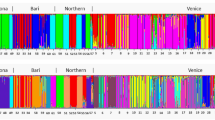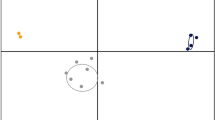Abstract
Genetic exchange among chromosomal races of the common shrew Sorex araneus and the problem of reproductive barriers have been extensively studied by means of such molecular markers as mtDNA, microsatellites, and allozymes. In the present study, the interpopulation and interracial polymorphism in the common shrew was derived, using fingerprints generated by amplified DNA regions flanked by short interspersed repeats (SINEs)—interSINE PCR (IS-PCR). We used primers, complementary to consensus sequences of two short retroposons: mammalian element MIR and the SOR element from the genome of Sorex araneus. Genetic differentiation among eleven populations of the common shrew from eight chromosome races was estimated. The NJ and MP analyses, as well as multidimensional scaling showed that all samples examined grouped into two main clusters, corresponding to European Russia and Siberia. The bootstrap support of the European Russia cluster in the NJ and MP analyses was respectively 76 and 61%. The bootstrap index for the Siberian cluster was 100% in both analyses; the Tomsk race, included into this cluster, was separated with the bootstrap support of NJ/MP 92/95%.
Similar content being viewed by others
References
Orlov, V.N. and Bulatova, N.Sh., Sravnitel’naya tsitogenetika i kariosistematika mlekopitayushchikh (Comparative Cytogenetics and Karyosystematics of Mammals), Moscow: Nauka, 1983.
Searle J.B., Three New Karyotypic Races of the Common Shrew Sorex araneus (Mammalia: Insectivora) and a Phylogeny, Syst. Zool., 1984, vol. 33, pp. 184–194.
Searle, J.B and Wojcik, J.M., Chromosomal Evolution: The Case of Sorex araneus, Evolution of Shrews, Wojcik, J.M. and Wolsan, M., Eds., Bialowieza: Mammal Res. Inst. Polish Acad. Sci., 1998, pp. 219–268.
Wojcik, J.M., Ratkiewicz, M., and Searle, J.B., Evolution of the Common Shrew Sorex araneus: Chromosomal and Molecular Aspects, Acta Theriologica, 2002, vol. 47,suppl. 1, pp. 139–167.
Wojcik, J.M., Borodin, P.M., Fredga, K., et al., The List of the Chromosome Races of the Common Shrew Sorex araneus (Updated 2002), Mammalia, 2003, vol. 67, no. 2, pp. 169–178.
Orlov, V.N., Bulatova, N.Sh., Kozlovskii, A.I., and Balakirev, A.E., Hierarchy of Intraspecific Taxa of Common Shrew Sorex araneus (Insestivora), and Taxonomic Species Structure in Mammals, Zool. Zh., 2004, vol. 83, no. 2, pp. 199–212.
Volobouev, V.T. and Catzeflis, F., Mechanisms of Chromosomal Evolution in Three European Species of the Sorex araneus-arcticus Group (Insectivora: Soricidae), Zeitschrift fur Zool. Systematik und Evolutionsforschung, 1989, vol. 27, pp. 252–262.
Zima, J., Is the Trend Toward Low 2Na Numbers Inescapable for Sorex araneus Populations?, Mem. Societe Vaudoise Sci. Natur., 1991, vol. 19, pp. 63–71.
Searle, J.B., Fedyk, S., Fredga, K., et al., Nomenclature for the Chromosomes of the Common Shrew (Sorex araneus), Mem. Societe Vaudoise Sci. Natur., 1991, vol. 19, pp. 13–22.
Ratkiewicz, M., Fedyk, S., Banaszek, A., et al., The Evolutionary History of the Two Karyotypic Groups of the Common Shrew, Sorex araneus, in Poland, Heredity, 2002, vol. 88, pp. 235–242.
Andersson, A.-C., Postglacial Population History of the Common Shrew (Sorex araneus) in Fennoscandia: Molecular Studies of Recolonisation, Sex-Biased Gene Flow and the Formation of Chromosome Races, Acta Universitatis Upsaliensis, Comprehensive Summaries of Uppsala Dissertations from the Faculty of Science and Technology 986, Uppsala: Uppsala Univ, 2004.
Bannikova, A.A., Bulatova, N.S., Lebedev, V.S., and Kramerov, D.A., Mitochondrial and Nuclear DNA Variability of the East European and Siberian Chromosome Races of the Common Shrew Sorex araneus, Evolution in the Sorex araneus Group: Cytogenetic and Molecular Aspects: 7th Meeting Intern. Sorex araneus Cytogenetics Committee (ISACC), St. Petersburg, 2005, pp. 14–15.
Ruedi, M., Protein Evolution in Shrews, Evolution of Shrews, Wojcik, J.M. and Wolsan, M., Eds., Bialowieza: Mammal Research Inst. Polish Acad. Sci., 1998, pp. 269–294.
Hedrick P.W., Highly Variable Loci and Their Interpretation in Evolution and Conservation, Evolution, 1999, vol. 53, pp. 313–318.
Balloux, F., Brunner, H., Lugon-Moulin, N., et al., Microsatellites Can Be Misleading: An Empirical and Simulation Study, Evolution, 2005, vol. 54, no. 4, pp. 1414–1422.
Lugon-Moulin, N., Balloux, F., and Hausser, J., Genetic Differentiation of Common Shrew Sorex araneus Populations among Different Alpine Valleys Revealed by Microsatellites, Acta Theriologica, 2000, vol. 45, no. 1, pp. 103–117.
Bannikova, A.A., Matveev, V.A., and Kramerov, D.A., Using Inter-Sine-RCR to Study Mammalian Phylogeny Rus. J. Genet., 2002, vol. 38, no. 6, pp. 714–724.
Bannikova, A.A., Lavrenchenko, L.A., and Kramerov, D.A., Phylogenetic Relationships between Afrotropical and Palaearctic Crocidura Species Inferred from Inter-SINE-PCR Data, Biochem. Syst. and Ecol., 2004, vol. 33, pp. 45–59.
Bannikova, A.A., Kramerov, D.A., Vasilenko, V.N., et al., DNA Polymorphism in Erinaceus Hedgehogs and Polytypicism of E. concolor (Insectivora, Erinaceidae), Zool. Zh., 2003, vol. 82, no. 1, pp. 1–11.
Matveev, V.A., Kruskop, S.V., and Kramerov, D.A., Revalidation of Myotis petax Hollister, 1912 and Its New Status in Connection with M. daubentonii (Kuhl, 1817) (Vespertilionidae, Chiroptera), Acta Chiropterologica, 2005, vol. 7, no. 1, pp. 23–37.
Bannikova, A.A., Bulatova, N.S., Krysanov, E.Y., and Kramerov, D.A., DNA Polymorphism of Sorex araneus and Its Relationships with Associated Species As Derived from Inter-SINE-PCR, Mammalia, 2003, vol. 38, no. 2, pp. 263–274.
Bulatova, N., Searle, J.B., Bystrakova, N., et al., The Diversity of Chromosome Races in Sorex araneus from European Russia, Acta Theriologica, 2000, vol. 45, no. Suppl. 1, pp. 33–46.
Polyakov, A.V., Panov, V.V., Ladygina, T.Yu., et al., Chromosomal Evolution of the Common Shrew Sorex araneus L. from the Southern Urals and Siberia in the Postglacial Period, Rus. J. Genet., 2001, vol. 37, no. 4, pp. 351–357.
Hausser, J., Fedyk, S., Fredga, K., et al., Definition and Nomenclature of Chromosome Races of Sorex araneus, Folia Zoologica, 1994, vol. 43, suppl. I, pp. 1–9.
Bulatova, N., Kalinin, A., Alexandrova, A., and Alexandrov, D., Perspectives of Studying a Border Zone between Two Chromosome Races—Moscow and Seliger—of Sorex araneus, Evolution in the Sorex araneus Group: Cytogenetic and Molecular Aspects, 6th Meeting Intern. Sorex araneus Cytogenetics Committee (ISACC), Paris, 2002, p. 18.
Bulatova, N., Shchipanov, N., and Searle, J., The Moscow-Seliger “Strong” Hybrid Zone—a Model System in European Russia, Evolution in the Sorex araneus Group: Cytogenetic and Molecular Aspects: 7th Meeting Intern. Sorex araneus Cytogenetics Committee (ISACC), St. Petersburg, 2005, p. 20.
Sheftel, B.I. and Krysanov, E.Yu., Chromosome Polymorphism of Race Neroosa (Sorex araneus) on the Territory with Radioactive Pollution After Chernobyl Accident, Evolution in the Sorex araneus Group: Cytogenetic and Molecular Aspects: 6th Meeting Intern. Sorex araneus Cytogenetics Committee (ISACC), Paris, 2002, pp. 29–30.
Sambrook, J., Fritsch, E.F., and Maniatis, T., Molecular Cloning: A Laboratory Manual, New York: Cold Spring Harbor Lab., 1989.
Smit, A. and Riggs, A., MIRs are Classic, tRNA-Derived SINEs that Amplified before the Mammalian Radiation, Nucl. Acids Res., 1995, vol. 23, no. 1, pp. 98–102.
Jurka, J., Zietkiewicz, E., and Labuda, D., Ubiquitous Mammalian-Wide Interspersed Repeats (MIRs) are Molecular Fossils from the Mesozoic Era, Nucl. Acids Res., 1995, vol. 23, no. 1, pp. 170–175.
Gilbert, N. and Labuda, D., Evolutionary Inventions and Continuity of CORE-SINEs in Mammals, J. Mol. Biol., 2000, vol. 298, pp. 365–377.
Borodulina, O.R. and Kramerov, D.A., Short Interspersed Elements (SINEs) from Insectivores: Two Classes of Mammalian SINEs Distinguished by A-Rich Tail Structure, Mammalian Genome, 2001, vol. 12, pp. 779–786.
Slatko, B.E and Albright, L.M., DNA Sequencing, in Short Protocols in Molecular Biology, Ausubel, F.M., et al., Eds., New York: Wiley, 1992, pp. 48–53.
Swofford, D.L., PAUP: Phylogenetic Analysis using Parsimony (and Other Methods), Version 4, Sunderland: Sinauer, 1998.
Nei, M. and Li, W.-H., Mathematical Model for Studying Genetic Variation in Terms of Restriction Endonucleases, Proc. Natl. Acad. Sci. USA, 1979, vol. 76, pp. 5269–5273.
Statsoft: Statistica for Windows, Tulsa: StatSoft, 1995, pp. 74 104–74 442.
Shchipanov, N.A., Population as a Unit of a Species Existence: Small Mammals, Zool. Zh., 2003, vol. 82, no. 4, pp. 450–469.
Trifonov, V.A., Perel’man, P.L., Romanenko, S.V., et al., Phylogenomics of Mammals: Cytogernetic Aspects, Biol. Membr., 2005, vol. 22, no. 3, pp. 212–226.
Orlov, V., Bulatova, N., Kozlovsky, A., et al., Karyotypic Variation of the Common Shrew (Sorex araneus) in European Russia: Preliminary Results, Hereditas, 1996, vol. 125, pp. 117–121.
Polyakov, A.V., Zima, J., Searle, J.B., et al., Chromosome Races of the Common Shrew Sorex araneus in the Ural Mountains: A Link Between Siberia and Scandinavia?, Acta Theriologica, 2000, vol. 45,suppl. 1, pp. 19–26.
Orlov, V.N. and Kozlovsky, A.I., On the Role of the Glacial Period in the Development of Chromosomal Polymorphism in Common Shrew Sorex araneus L. (Insestivora, Mammalia), Dokl. Akad. Nauk, 2002, vol. 386, pp. 423–426.
Author information
Authors and Affiliations
Additional information
Original Russian Text © A.A. Bannikova, N.S. Bulatova, D.A. Kramerov, 2006, published in Genetika, 2006, Vol. 42, No. 6, pp. 737–747.
Rights and permissions
About this article
Cite this article
Bannikova, A.A., Bulatova, N.S. & Kramerov, D.A. Molecular variability in the common shrew Sorex araneus L. from european russia and siberia inferred from the length polymorphism of DNA regions flanked by short interspersed elements (inter-SINE PCR) and the relationships between the moscow and seliger chromosome races. Russ J Genet 42, 595–604 (2006). https://doi.org/10.1134/S1022795406060020
Received:
Issue Date:
DOI: https://doi.org/10.1134/S1022795406060020




